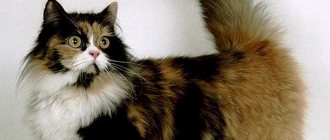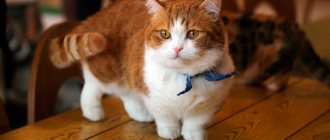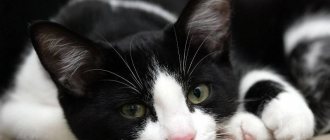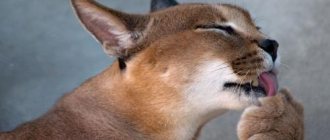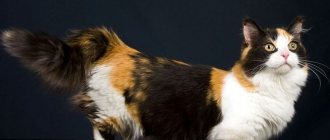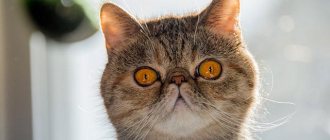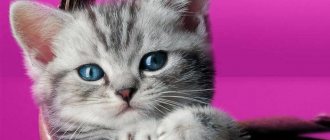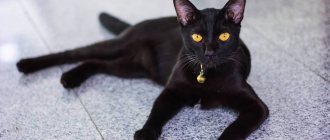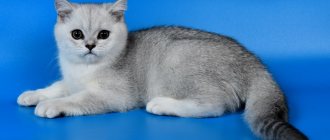Origin
When I tell you “short-legged cats,” you will immediately understand what I’m talking about; short legs are the distinguishing feature of Munchkins. They first appeared in America back in the 20-30s of the last century, not so long ago. In the vastness of the state of Louisiana, a group of researchers accidentally found a cat with short legs, which was a great surprise for everyone; they named her Blackberry (translating into Russian, of course).
Nobody knows how and where she came from, but after the cat gave birth, and it turned out that her kittens (only some of them) also had short legs, they decided to officially register a new breed.
The story behind their name is also quite funny. It was taken from the world-famous work, and subsequently the film adaptation of “The Wizard of Oz”; dwarf munchkins are described in detail on the pages of the novel. They were tiny creatures with short legs, which is perhaps why munchkins became the prototype for these cats.
Health
Characteristic diseases
Due to the shortening of long bones and the normal length of the spine, as well as the desire of breeders to produce kittens with an interesting color or appearance, munchkins may suffer from the following diseases:
- Spinal lordosis occurs when an adult animal is overweight and has low mobility. The spine acquires an excessively pronounced bend in the chest area, causing internal organs to suffer. Lordosis can be prevented by providing the cat with conditions for playing and walking, and without overfeeding him.
- Genetic abnormalities leading to cardiopathy and death in young animals occur when munchkins are mated with carriers of dominant genes for lop ears or short tail. A stiff or insufficiently flexible tail may be the only sign of future heart problems in a kitten. In Europe, breeding munchkins with breeds that carry lethal genes is prohibited.
Munchkin's expressive eyes can amaze anyone
Vaccinations
All kittens that have reached the age of two months are vaccinated with Nobivak Triket, Fellovax or Multifel-4 vaccines.
These vaccines protect the baby from common viral diseases: calcivirus, panleukopenia and rhinotracheitis.
Repeated vaccination is carried out according to the schedule, no earlier than three weeks from the date of the first vaccination.
After this, the animal is vaccinated at one year of age with a multivalent vaccine containing rabies.
Rabies is considered a quarantine disease, so all domestic cats and dogs must be vaccinated against it annually.
Kittens need rabies vaccination only if they are transported within the country or abroad, as well as to attend exhibitions.
The famous munchkin pose - to look around, the cat sits on the seat and firmly rests its tail
Photo
<,>,
Description of the breed
- Body type: short legs, small, their body is no different from the body of ordinary cats, they have not even lost their grace. Cats' hind limbs are slightly longer, causing slight elevations to appear on the body. The muscles are very developed. Weight does not exceed 4 kilograms, height – 16 centimeters. The head is proportional to the body, the nose is small, the back of the head is rounded.
- Limbs: The legs of these breeds are very short by standard. There are three types: from the smallest sizes to the largest. A slight curvature of the front legs is allowed. The shape of the paws is round and small.
- Tail: the same as that of ordinary cats, thick, whip-like.
- Ears: medium, set high, but in full proportion to the size of the head, wide at the base, slightly rounded at the ends.
- Eyes: large, expressive, almond-shaped. May be: green, sky blue, brown, chalk color. Eye color is completely independent of color, but cats with white fur most often have heterochromia (that is, different eye colors)
- Coat: There are both long-haired and short-haired varieties. The coat is shiny and elastic, with moderate undercoat. There may be tassels on the ears, fluffy paws or a loose tail. The color can be different, it all depends on the parents, the least common are chocolate shades and cold marble ones. Breeds with this color are very valuable!
- Obvious shortcomings : too arched back, protruding chest, Siamese type.
- Crossbreeding : acceptable with any breeds
To read: How to give an original name to a Yorkshire Terrier dog: nicknames for girls and boys
Munchkin colors
They do not have an unconditional list of colors. The standard does not prohibit different colors. This is due to the natural origin of animals, and not through artificial breeding.
At exhibitions you can see such cats of various colors:
- rich red;
- gray;
- white;
- chocolate;
- marble;
- black.
Unusual color of the breed
A combination of several colors, as well as the presence of spots and stripes, is allowed.
Since the breed is still experimental, it is allowed to breed cats of any color. But there are plans to develop uniform color requirements by 2025.
Character
These cats themselves evoke affection, which is why their character is kind, soft and flexible. They don’t do any mischief, simply because their legs are short and do not allow them to climb onto the table and “accidentally” throw off dishes, an expensive Chinese vase or a crystal cup. It is for this reason that Munchkins are considered an exclusively domestic breed; how will they hunt with such paws?
Cats of this breed are very mobile and active, if you decide to play with them, they will be very happy. They are quite indifferent to toys. And even though their legs are short, they love to run. It’s especially funny when they freeze in a pose on their hind legs, you look and don’t understand whether your cat is meditating or praying at that moment.
They are also not aggressive with children, but how can such cute creatures be aggressive? They play calmly and do not cause any inconvenience. They are neutral with strangers, like all cats - they will sniff, walk and leave.
In general, if you decide to buy the kindest cat in the world, then this is a Munchkin. And don’t think that if they have short legs, then you should definitely feel sorry for them, they live quite comfortably and comfortably in such conditions.
Application
Munchkins can be not only a cute pet, but also play the role of a true friend, like a Thai cat , act as an excellent nanny for kids and a calm, unobtrusive listener for an elderly person.
This breed is distinguished by its exceptional ability to adapt to any conditions, subtly sense all changes in a person’s mood and get along with other pets.
Munchkins have a tendency to take small things and hide them in a secluded place.
The Munchkin cat breed is ideal for beginners, as its representatives have excellent health, are not capricious in food and do not require special conditions.
Unfortunately, these cats cannot catch mice and rats due to their short front legs, and can also die if kept freely on the street, but this also applies to many other breeds of cats.
Popular diseases
The most obvious problem of these cats is, of course, the back, lordosis of the spine, that is, its stretching. This problem is quite dangerous, but it is treatable; it is most often transmitted genetically. Subsequently, this disease may cause problems with other organs - liver, heart, lungs.
Another reason for this disease may be obesity. You understand how you can carry 4 kilograms of weight, or even more, on such small paws. Even overweight people have problems with their spine all the time. Therefore, owners of cats of this wonderful breed must monitor their diet, otherwise diseases will inevitably occur.
Life expectancy is 15-16 years; with proper care and an active lifestyle, this limit can reach up to 20 years.
Diseases and health problems
They are distinguished by strong immunity from birth. But short legs make themselves felt. This leads to some diseases of the spinal column (for example, lordosis) in many cats. As a result, the muscle frame in the chest area is weakened, which leads to problems with movement, as well as cardiac and pulmonary pathologies.
The cause of lordosis may be heredity. Therefore, experts advise trusting professional breeders when it comes to mating. Only they are able to choose the right Munchkin partner to avoid genetic diseases.
Lordosis can develop against the background of obesity. Therefore, you need to vigilantly monitor your pet’s diet, avoiding overfeeding. If the weight is exceeded, the pet is put on a diet.
Care
No special care is needed.
- Bathing once every two weeks using special shampoos, do not under any circumstances think about washing your cat with your own shampoos - this can be very dangerous! Take a small amount of shampoo, lather it, and wash from head to tail. Don’t soap your hair, and don’t move your hand against the grain! Before bathing, it is better to plug your ears with cotton wool, otherwise water that gets there can cause unnecessary trouble. They, like all representatives of this genus, do not like water procedures very much, but they can be taught, fortunately it is not so difficult to do 2.
- We clean the ears very carefully with a special stick or a small piece of cotton wool. For deep cleaning of the ears, buy a special solution at a veterinary pharmacy. When cleaning, also inspect to see if any allergic reactions or dark spots are noticed.
- Eyes should be wiped daily with a cotton pad or damp cloth. You can also use solutions, if you don’t have any at hand, moisten them with simple boiled water, only very warm, or with a not hot solution of tea leaves.
- We brush the fur regularly, especially if you have a long-haired Munchkin.
- Be sure to keep an eye on your claws if you don’t want your furniture to be damaged! It's better to buy a special scratching post at your nearest store! If you can’t buy a scratching post, then trim the claws, but you need to do this very carefully, since cats have a lot of nerve endings going to their claws.
- Teeth. We always forget about this. Yes, they also need care, and they need to be cleaned using special pastes once a month or as needed. Clean not with your fingers, of course, but with a brush; you can buy an ordinary small children's brush.
To read: Features of caring and feeding a Chihuahua at home
Get used to the Munchkin procedures right away, from childhood, this may cause some difficulties, but then these procedures will take you about 20 minutes, no more.
Genetics of Munchkin birth
The exact reason for the Munchkin's short legs has not yet been established. This mutation occurred spontaneously and did not affect other organs of the animal. Of course, breeders do not deliberately inhibit the growth of limbs with the help of special medications and other methods.
The gene responsible for this feature is selectively inherited by cats. So a litter can have kittens with both short and long legs. Work on studying the unknown gene is still underway. American scientists are especially active in this. They published the results of their many years of effort in the BioRxiv electronic repository.
Nutrition
The most important aspect is nutrition! As mentioned above, overfeeding can be fraught, so it’s better to think about your pet in advance. It’s better, of course, if you don’t want to take risks, then buy special food for Munchkins, which contains all the necessary elements to maintain physical health and further development.
If you adhere to natural feeding, then make it as balanced and healthy as possible. Take care of your cat from childhood.
It is best to give:
- Dairy products: cottage cheese or kefir, milk will not be beneficial, especially for kittens, since their stomachs do not digest such food well.
- Chicken, lean meat, preferably in the form of minced meat, chicken skin can also become a danger to the cat’s stomach
- Boiled fish, but it must be pre-cleaned from bones, although cats themselves, of course, can clean the fish, but it is better to protect your pet.
- Cereals and vegetables are good for feeding
- Don't forget to give vitamins, but buy only those recommended by your veterinarian, do not self-medicate.
What to feed
Animals are not picky eaters, but still require careful selection of foods in their diet. Dry and wet food of the highest quality, or natural products are suitable for them.
They are allowed to give: lean meat, white fish, cereals, eggs and vegetables.
The following should not be included in the diet: bread, potatoes, salty soup, canned food and pasta.
Where can I buy?
This breed is not so widespread in Russia at the moment, so it will not be easy to get it; you will have to find special people who are directly involved in breeding this breed. You can purchase them through special websites, fortunately such are available today.
But, be careful, because these breeds are very often “fake”. If you still decide to buy a Munchkin kitten, then you need to ask the breeder a number of questions:
- How old are mom and dad? Do you want to know more about their origin?
- How many matings did the parents have and what was the number?
- Did your parents get sick and with what?
- Do mom and dad have any dangerous genetic diseases?
- How and when was the birth, was everything okay, how does the “mother” feel?
- What treatment was given to the kittens immediately after birth (for worms, etc.)?
- Are the kittens vaccinated? (if yes, then what, when and how they installed it)
- Have you been neutered/neutered?
- What is the temperament of the ancestors and the chosen kitten?
- Do kittens need to be litter trained?
- How do kittens eat?
- What is used as feed?
- How to care for a munchkin, how to maintain it?
To read: The most popular and special nicknames for Scottish Fold cats and cats: description of the breed
There must be documents for the kitten. Assess the attitude towards kittens, how the person who breeds cats treats them, whether they are intimidated. Inspect the room where the kittens lived, it can tell a lot. And, of course, evaluate the conditions of detention.
Dependence of price on class
1. Show class. These are cats that best meet the standard of external characteristics and have an outstanding pedigree. Animals are distinguished by excellent health, stable psyche, and do not have developmental disabilities.
Show class kittens are not neutered; they are the standard of the breed and are allowed for breeding.
The elite class includes munchkins with the shortest legs. Show-class cats cost from 80,000 to 200,000 rubles.
2. Breeding class. The kittens also meet the standard, are healthy, can participate in exhibitions, and are allowed for breeding. But they have some disadvantages that do not allow them to be classified as the highest class.
The average cost of a kitten is 20,000 – 80,000 rubles.
3. Pet class. The cheapest animals. Such kittens do not have documents and have significant defects in appearance. Cats are not allowed for exhibitions or breeding.
Pet-class kittens cost from 2,000 to 15,000 rubles.
Little munchkin kitten/Yandex Collections
Separately, munchkin hybrids can be distinguished. Cats are crossed with representatives of other breeds.
The result is short-legged cats with the external characteristics of a certain breed. There are many munchkin hybrids, they all have their own names.
In general, they are called by a common word - dwarves (gnomes).
You can only find out how much such a cat costs from private breeders.
Hybrids are considered illegally bred, are not sold in nurseries and are much cheaper than purebred munchkins.
Reviews
Most often, people who purchased this breed noted that these cats are exclusively domestic, and their growth is so small that sometimes it is difficult to notice them underfoot. Those who have children noted that cats are very playful and harmless. Cleanliness and neatness were also noted as a plus, and they quickly get used to the toilet. In general, they do not cause any special problems for their owners; they just need to pay closer attention to their “fragile” health.
Did you think only dachshunds have short legs? But no! Munchkins are special cats with short legs, very gentle and kind domestic creatures. But, like any cats, they require careful care! Take care of your pet and remember, you are responsible for those you tamed!
Caring for Munchkin cats
Munchkin kittens are very clean from a very early age, so they require a cat litter box with large sides or a completely enclosed one.
Due to the fact that these pets are extremely curious, you will have to put away those items that you do not want to lose in the very near future.
It is also better to remove objects that are toys for the cat while everyone in the house is sleeping, otherwise the munchkin, not caring about all the existing rules regarding night and sleep, will rush from corner to corner with some noisy little thing in its teeth.
Despite the fact that a munchkin cat is unlikely to climb to too great a height, it is also necessary to have a scratching post in the house. For those who are just planning to accustom their kitten to this useful device, there is some advice - you need to rub the scratching post with catnip.
Munchkins with short hair are brushed every week, while those with long hair are brushed more often, about two or three times a week. You can determine how often you need to comb an animal only by experience, that is, by observing how quickly tangles appear on the fur. There are no other special features in caring for cats belonging to the Munchkin breed.
